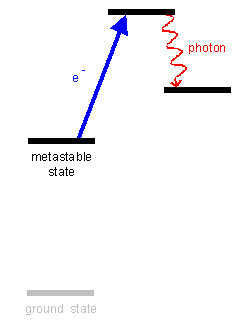Excitation out of Metastable States
Fast Beam Metastable Source
worthless factoids:
-began construction: 1990
-Annual Consumption of:
-water: ~1 million gallons
-power: 150 MW hours
-gas: 70 liters at STP

What are Metastable States?
Atoms can be excited (by lasers, electron collisions, etc.) to energy levels above their ground states. Normally, these levels are short-lived and the atoms quickly decay (in 10-9 sec or less) back to the ground state. Some levels, however, can not decay to the ground state by the standard dipole-selection rules. These long-lived levels are called metastable levels. For example, in helium the first two excited levels (the 21S and 23S levels) are both metastable, with lifetimes on the order of seconds. We measure cross sections for electron-impact excitation out of the metastable levels into higher excited levels.How are Metastable Atoms created?
The study of electron-metastable atom collisions is complicated by the difficulty of producing targets of metastable atoms in the lab. This experiment uses charge exchange between a He+ (or Ne+,Ar+,...) beam and a cesium vapor. The metastable levels of helium (or argon) are near-resonant with the ground state of cesium. Thus most of the emerging atoms are in the metastable levels (as compared to the ground state).This allows the fast beam experiment to work at higher electron energies than the hollow cathode experiment. The price we pay is a much lower metastable target density of about 105 atoms/cm3.
More information on this experiment.
How does the experiment work?

He+ (or Ne+,Ar+,...) are formed in the RF discharge at the far left. The ion beam is focused using a number of Einzel Lens (E1,E2) and steered using the horizontal and vertical deflection plates (H,V). The ion beam passes through the Cs vapor in a recirculating oven (X). In the Ion Beam Deflection Chamber the remaining ions are removed from the fast atom beam with another set of deflection plates (D). In the next chamber a variable-energy electron beam (E/F) crosses the atomic beam at a right angle. The metastables are excited into higher levels, and when these levels decay, they emit visible radiation. This emitted radiation is measured using a photomultiplier tube (PMT) and from this information we can extract cross sections. The amount of metastable atoms in the beam is measured with a neutral detector (ND) in the last chamber.
Some experimental specs:
| Target Density: | 105 to 106 metastables/cm3 ( 0.1 to 1 particle µA ) |
| Electron energy range: | 0 to 2000 eV |
| Electron beam current: | 150 µA at 50 eV |
| Atoms studied: | He(21S) and He(23S) metastables (more than 4 levels studied) Ar( 1s3 ) and Ar( 1s5 ) metastables (3 levels studied) Ne( 1s5 ) metastable level (5 levels studied) Kr( 1s5 ) metastable level (2 levels studied) Xe( 1s5 ) metastable level (1 level studied) |
Recent Published Results
- Measurement of electron-impact excitation cross sections out of the neon 3P2 metastable level
-
John B. Boffard, M. L. Keeler, Garrett A. Piech, L. W. Anderson, and Chun C. Lin,
Phys Rev. A 64 (2001) 032708.
- Use of a fast beam target for the determination and reduction of the cascade contribution to electron excitation cross-section measurements
-
J. B. Boffard, M. F. Gehrke, M. E. Lagus, L. W. Anderson, and C. C. Lin,
Eur. Phys. J. D 8 (2000) 193-198.
- Measurement of electron-impact excitation cross sections out of metastable levels of argon and comparison with ground-state excitation
-
John B. Boffard, Garrett A. Piech, Mark F. Gehrke, L. W. Anderson, and Chun C. Lin,
Phys Rev. A 59 (1999) 2749-2763.
- Electron-impact-excitation cross sections out of the 23S metastable level of helium at high energies
-
John B. Boffard, Mark E. Lagus, L. W. Anderson, and Chun C. Lin,
Phys Rev. A 59 (1999) 4079-4082.
- Apparatus for measuring electron-impact excitation cross sections using fast metastable atoms produced via charge exchange
-
John B. Boffard, Mark E. Lagus, L. W. Anderson, and Chun C. Lin,
Rev. Sci. Instrum. 67 (1996) 2738-2751.
- Cross sections of electron excitation out of metastable helium levels with a fast metastable target produced via charge exchange
-
Mark E. Lagus, John B. Boffard, L. W. Anderson, and Chun C. Lin,
Physical Review A 53 (1996) 1505-1518.
back to experiments list... back to home page